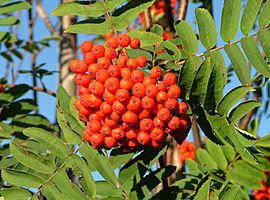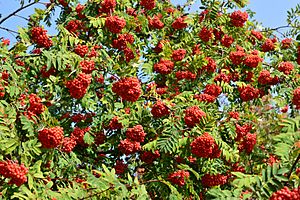Rowan facts for kids
Quick facts for kids Rowan |
|
|---|---|
 |
|
| European Rowan fruit | |
| Scientific classification | |
| Kingdom: | |
| Division: | |
| Class: | |
| Order: | |
| Family: | |
| Subfamily: | |
| Genus: |
Sorbus
|
| Subgenus: |
Sorbus
|
A Rowan is a type of plant that grows tasty fruit. It belongs to the Rosaceae family, which also includes apples and hawthorns. You can find rowan trees in cooler parts of Europe and Asia.
The fruit of a rowan tree is usually a small, round berry. It's about 4 to 8 mm wide. Most rowan berries are bright orange or red. But some types from Asia can have pink, yellow, or even white berries! These berries are soft and juicy.
The most famous type is the European Rowan (Sorbus aucuparia). It's a small tree, usually 4 to 12 meters tall. It grows in many places across northern Europe and in mountains in southern Europe and southwest Asia. Birds love to eat its berries. People in Britain and Scandinavia have also collected these wild berries for a long time.
In North America, you can find native rowans like the American Rowan (Sorbus americana) and Showy Rowan (Sorbus decora) in the east. The Sitka Rowan (Sorbus sitchensis) grows in the west. Many other similar rowan types from Asia are grown as pretty trees in gardens.
Contents
What's in a Name? Rowan's Many Titles
The name "rowan" comes from an old Norse word, raun or rogn. Experts think this Norse word came from an even older word meaning "getting red." This makes sense because rowan trees have red leaves and berries in autumn!
Rowan is a very well-known wild tree in the British Isles. Because of this, it has many different folk names in English. Some of these names are:
- Mountain ash
- Quickbane
- Quickbeam
- Quicken tree
- Ran tree
- Rune tree
- Witch wood
Many of these names are linked to old stories and beliefs about the tree. In the Gaelic language, it's called Rudha-an, which means "red one."
One name that can be confusing is "mountain ash." This name is still used in North America. It makes people think the rowan is a type of ash (Fraxinus). But this is not true! Rowan trees just have leaves that look a bit like ash leaves. In reality, the rowan is not related to the ash family at all. It's actually a close cousin to apples and hawthorns, all part of the rose family.
How People Use Rowan Trees
Rowan trees are great for making parks, gardens, and wildlife areas look beautiful. They are small and ornamental. Some types from China, like the White-fruited rowan (S. glabrescens), are popular because their berries are an unusual white color. Sargent's rowan (S. sargentiana) is loved for its very large groups of fruit.
Birds really like to eat rowan berries. This is why one old name for the tree was "bird catcher." The wood from rowan trees is strong and heavy. People use it for carving, making tool handles, and even walking sticks.
Rowan in Old Stories and Magic
The European rowan (S. aucuparia) has a long history in European stories and beliefs. People used to think it was a magical tree. They believed it could protect them from evil spirits and bad things.
Because rowan wood is so strong, it was often used for walking sticks and even magician's staffs. People believed these staffs would protect them on journeys at night. This is why staffs used by ancient druids were often made from rowan wood. The magic linked to rowan was not just for protection. Some stories say that rowan wood could make a person's psychic powers stronger. Its branches were often used in magical wands.
People also carried rowan branches on boats to stop storms. They kept rowan wood in their homes to protect against lightning. Some even planted rowan trees on graves to keep the dead from haunting. It was also used to protect people from witches.
Sometimes, birds drop rowan seeds. If a seed lands in a crack or hole in a bigger tree, like an oak or a maple, a rowan tree might start to grow there. This rowan is called a "flying rowan." People believed these "flying rowans" were extra powerful against witches and their magic. They were also thought to be strong charms against sorcery.
Rowan Berries as Food and Medicine
Rowan berries are usually too bitter to eat raw. But you can make a delicious, slightly bitter jelly from them. In England, this jelly is often eaten with game meat.
The berries can also be used instead of coffee beans. They are used in many alcoholic beverages too. People use them to flavor liqueurs and cordials. They can also be used to make country wine and to flavor ale.
Some types of rowan trees have berries that are better for people to eat. But these are not very common. Most of the time, people gather rowan berries from wild trees growing in public places.
In old folk medicine, fresh rowan berry juice was used as a laxative. It was also used as a gargle for sore throats, swollen tonsils, and hoarseness. Rowan berries are a good source of vitamins A and C. Rowan berry jam was sometimes used to help with diarrhea.
Images for kids
See also
 In Spanish: Sorbus subg. Sorbus para niños
In Spanish: Sorbus subg. Sorbus para niños





